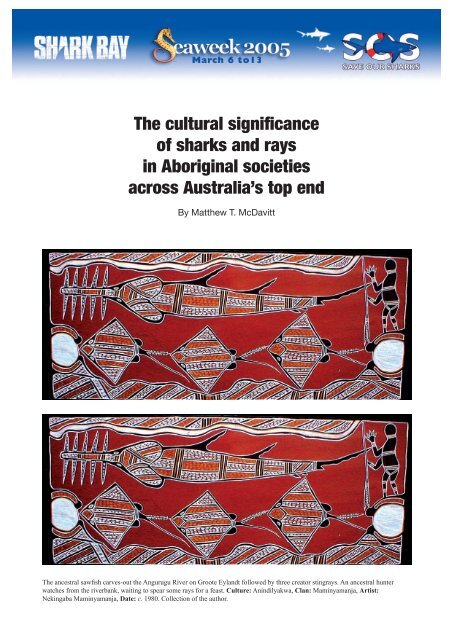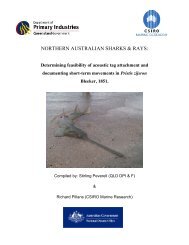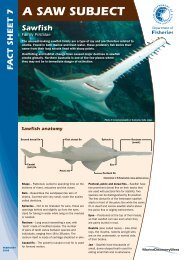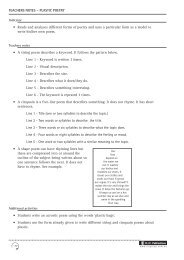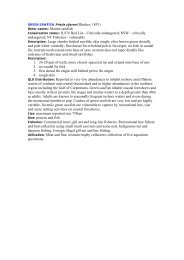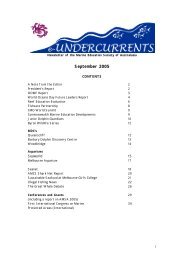The cultural significance of sharks and rays in Aboriginal societies ...
The cultural significance of sharks and rays in Aboriginal societies ...
The cultural significance of sharks and rays in Aboriginal societies ...
You also want an ePaper? Increase the reach of your titles
YUMPU automatically turns print PDFs into web optimized ePapers that Google loves.
<strong>The</strong> <strong>cultural</strong> <strong>significance</strong><br />
<strong>of</strong> <strong>sharks</strong> <strong>and</strong> <strong>rays</strong><br />
<strong>in</strong> Aborig<strong>in</strong>al <strong>societies</strong><br />
across Australia’s top end<br />
By Matthew T. McDavitt<br />
<strong>The</strong> ancestral sawfish carves-out the Angurugu River on Groote Eyl<strong>and</strong>t followed by three creator st<strong>in</strong>g<strong>rays</strong>. An ancestral hunter<br />
watches from the riverbank, wait<strong>in</strong>g to spear some <strong>rays</strong> for a feast. Culture: An<strong>in</strong>dilyakwa, Clan: Mam<strong>in</strong>yamanja, Artist:<br />
Nek<strong>in</strong>gaba Mam<strong>in</strong>yamanja, Date: c. 1980. Collection <strong>of</strong> the author.
THE CULTURAL SIGNIFICANCE OF SHARKS<br />
AND RAYS IN ABORIGINAL SOCIETIES<br />
ACROSS AUSTRALIA’ S TOP END<br />
by Matthew T. McDavitt<br />
3371 Turnberry Circle, Charlottesville, VA 22911,<br />
United States <strong>of</strong> America<br />
Introduction<br />
When the first fleet <strong>of</strong> European settlers arrived <strong>in</strong> Australia<br />
<strong>in</strong> 1788, an estimated 300 000 to over one million Aborig<strong>in</strong>al<br />
peoples <strong>in</strong>habited the cont<strong>in</strong>ent. <strong>The</strong>y were organised <strong>in</strong>to a<br />
large number <strong>of</strong> diverse <strong>societies</strong>, speak<strong>in</strong>g over 200 dist<strong>in</strong>ct<br />
languages. Today, more than 460 000 Aborig<strong>in</strong>al peoples<br />
<strong>in</strong>habit Australia <strong>and</strong> at least 20 languages rema<strong>in</strong> both spoken<br />
<strong>and</strong> viable.<br />
Today, <strong>sharks</strong> <strong>and</strong> <strong>rays</strong> cont<strong>in</strong>ue to be important to Aborig<strong>in</strong>al<br />
peoples throughout coastal Australia, as they were <strong>in</strong> the past.<br />
In Aborig<strong>in</strong>al cultures these animals symbolise both their<br />
connection to the l<strong>and</strong> <strong>and</strong> sea, as well as provid<strong>in</strong>g critical<br />
food resources at certa<strong>in</strong> times <strong>of</strong> the year.<br />
Orig<strong>in</strong> <strong>of</strong> animal symbols<br />
Animals are a common <strong>in</strong>spiration for symbol <strong>and</strong> metaphor<br />
<strong>in</strong> every society. Early Western economies were largely based<br />
on farm<strong>in</strong>g <strong>and</strong> herd<strong>in</strong>g, <strong>and</strong> as a result, many animal symbols<br />
<strong>and</strong> metaphors were <strong>in</strong>spired by <strong>in</strong>teractions with domesticated<br />
animals, for example: good egg, pigsty, count your chickens,<br />
gentle as a lamb, <strong>and</strong> gift horse. Western dependence on farm<br />
animals tended to demonise predators which were thought to<br />
threaten livestock or compete with mank<strong>in</strong>d for resources. Thus<br />
our ancestors despised the wolf at the door, the fox guard<strong>in</strong>g<br />
the hen house, <strong>and</strong> the snake <strong>in</strong> the grass. <strong>The</strong> image <strong>of</strong> <strong>sharks</strong><br />
is particularly negative <strong>in</strong> Western culture. For many <strong>of</strong> us they<br />
symbolise predatory behaviour, greed, gluttony, danger, <strong>and</strong><br />
deceit, <strong>in</strong>spir<strong>in</strong>g negative metaphors such as: swimm<strong>in</strong>g with<br />
the <strong>sharks</strong>, loan shark, shark lawyer, <strong>and</strong> feed<strong>in</strong>g frenzy.<br />
‘Popular’ Western attitudes towards <strong>sharks</strong> <strong>and</strong> <strong>rays</strong> are<br />
traditionally negative; however, this is slowly chang<strong>in</strong>g as<br />
people become more <strong>in</strong>formed. As epitomised by the <strong>in</strong>famous<br />
movie Jaws, <strong>sharks</strong> are viewed as m<strong>in</strong>dless eat<strong>in</strong>g mach<strong>in</strong>es—<br />
they cont<strong>in</strong>ue to haunt our nightmares <strong>in</strong> an age largely devoid<br />
<strong>of</strong> animal monsters. Popular knowledge <strong>of</strong> elasmobranch<br />
(cartilag<strong>in</strong>ous fishes; <strong>sharks</strong> <strong>and</strong> <strong>rays</strong>) diversity is equally poor.<br />
To Westerners, almost every shark is thought to be a great<br />
white (Carcharodon carcharias), tiger shark (Galeocerdo<br />
cuvier), or hammerhead (Sphyrna spp.). <strong>The</strong> <strong>rays</strong> have virtually<br />
no symbolism <strong>in</strong> the Western tradition.<br />
For Aborig<strong>in</strong>al <strong>societies</strong>, whose economies were traditionally<br />
grounded on the hunt<strong>in</strong>g <strong>and</strong> gather<strong>in</strong>g <strong>of</strong> wild foods, animal<br />
symbols were naturally based on wild animal species.<br />
Incorporat<strong>in</strong>g predators like <strong>sharks</strong> <strong>in</strong>to religious symbolism<br />
might seem unusual to Westerners, but it is not really so<br />
strange; we cont<strong>in</strong>ue to view certa<strong>in</strong> predators as represent<strong>in</strong>g<br />
positive qualities like strength (the bear), bravery (the eagle), or<br />
nobility (the lion). For many coastal Aborig<strong>in</strong>al peoples, certa<strong>in</strong><br />
<strong>sharks</strong> <strong>and</strong> <strong>rays</strong> have similar positive associations <strong>and</strong> symbolic<br />
value.<br />
Indigenous <strong>and</strong> Western classification<br />
<strong>The</strong>re are approximately 66 elasmobranch species <strong>in</strong>habit<strong>in</strong>g<br />
the Gulf <strong>of</strong> Carpentaria <strong>in</strong> northern Australia. As these are<br />
tropical waters, <strong>sharks</strong> familiar to most Westerners such as the<br />
great white <strong>and</strong> mako (Isurus<br />
spp.) are absent. Of the species<br />
present, many <strong>of</strong> the whaler shark <strong>and</strong> st<strong>in</strong>gray species are<br />
almost <strong>in</strong>dist<strong>in</strong>guishable except to a tra<strong>in</strong>ed zoologist. Thus,<br />
<strong>of</strong> the 66 species present, only about 28 species would be<br />
recognisable as dist<strong>in</strong>ct to a non-scientist, based on features<br />
like body mark<strong>in</strong>gs <strong>and</strong> unique anatomical features. <strong>The</strong><br />
average Australian <strong>of</strong> European ancestry could probably identify<br />
only two or three species with unique features such as the tiger<br />
shark <strong>and</strong> hammerhead. <strong>The</strong>re are <strong>of</strong>ten several common names<br />
referr<strong>in</strong>g to the same species depend<strong>in</strong>g on whom you talk<br />
to <strong>and</strong> where they are from. In contrast, Top End Aborig<strong>in</strong>al<br />
<strong>societies</strong> generally recognise over twenty named species.<br />
Aborig<strong>in</strong>al knowledge <strong>of</strong> <strong>sharks</strong> <strong>and</strong> <strong>rays</strong> is more balanced<br />
than the negative image <strong>sharks</strong> hold <strong>in</strong> the European tradition.<br />
Unlike most Australians <strong>of</strong> European ancestry, Aborig<strong>in</strong>al<br />
groups recognise a wide diversity <strong>of</strong> species <strong>and</strong> they are<br />
able to observe them <strong>in</strong> their habitat. This familiarity has<br />
encouraged a more realistic image <strong>of</strong> elasmobranchs <strong>in</strong><br />
<strong>in</strong>digenous thought. While they certa<strong>in</strong>ly recognise that some<br />
species such as tiger <strong>sharks</strong> <strong>and</strong> bull <strong>sharks</strong> are potentially<br />
dangerous at certa<strong>in</strong> sizes, they also know that most species are<br />
harmless to mank<strong>in</strong>d. <strong>The</strong>y do not have an unreason<strong>in</strong>g fear <strong>of</strong><br />
the dangerous <strong>sharks</strong>. Instead they view them as powerful <strong>and</strong><br />
worthy <strong>of</strong> respect, just as Westerners see eagles <strong>and</strong> lions as<br />
models <strong>of</strong> <strong>in</strong>dependence, bravery, <strong>and</strong> might.<br />
Because Aborig<strong>in</strong>al <strong>societies</strong> are familiar with a wider diversity<br />
<strong>of</strong> <strong>sharks</strong> <strong>and</strong> <strong>rays</strong>, they f<strong>in</strong>d symbolic value <strong>in</strong> a much wider<br />
array <strong>of</strong> species as well. Whereas Western cultures generally<br />
depict only a few k<strong>in</strong>ds <strong>of</strong> <strong>sharks</strong>, <strong>in</strong>digenous <strong>societies</strong> f<strong>in</strong>d<br />
mean<strong>in</strong>g <strong>in</strong> species largely ignored <strong>in</strong> the West. Among the<br />
<strong>sharks</strong>, hammerheads <strong>and</strong> tigers are certa<strong>in</strong>ly important, but<br />
so are more unfamiliar species. Whaler <strong>sharks</strong> are <strong>of</strong> central<br />
importance. <strong>The</strong> fact that certa<strong>in</strong> <strong>sharks</strong>, such as the <strong>in</strong>famous<br />
bull shark (Carcharh<strong>in</strong>us leucas) (figure 1) <strong>and</strong> the poorly<br />
1
Figure 1. <strong>The</strong> fact that certa<strong>in</strong> <strong>sharks</strong>, such as the <strong>in</strong>famous bull shark<br />
(Carcharh<strong>in</strong>us leucas) enter freshwater rivers <strong>and</strong> lakes, is very<br />
mean<strong>in</strong>gful for some Aborig<strong>in</strong>al groups (© Andrea Marshall).<br />
Figure 4. Eagle ray (Aetobatus nar<strong>in</strong>ari) (© CSIRO Mar<strong>in</strong>e Research).<br />
Figure 2. Speartooth shark (Glyphis spp.)<br />
(© CSIRO Mar<strong>in</strong>e Research).<br />
Figure 5. Sawfish (Pristis clavata) (© CSIRO Mar<strong>in</strong>e Research).<br />
Sharks <strong>and</strong> <strong>rays</strong> as resources<br />
Figure 3. Shovelnose ray (Rh<strong>in</strong>obatos typus)<br />
(© CSIRO Mar<strong>in</strong>e Research).<br />
known speartooth shark (Glyphis glyphis)<br />
(figure 2), enter freshwater rivers <strong>and</strong> lakes, is very mean<strong>in</strong>gful<br />
for some Aborig<strong>in</strong>al groups; <strong>in</strong> contrast, it is only recently<br />
that Westerners have become aware that some <strong>sharks</strong> enter<br />
freshwater. For the <strong>rays</strong>, many st<strong>in</strong>gray species are important<br />
symbols, as are shovelnose <strong>rays</strong> (Rh<strong>in</strong>obatos typus) (figure 3),<br />
eagle <strong>rays</strong> (Aetobatus nar<strong>in</strong>ari) (figure 4), manta <strong>rays</strong> (Mobula<br />
spp.), <strong>and</strong> sawfishes (Pristis<br />
spp.) (figure 5).<br />
Although elasmobranchs are highly symbolic <strong>in</strong> Aborig<strong>in</strong>al<br />
society, they are also valued as a source <strong>of</strong> food <strong>and</strong> raw<br />
materials. <strong>The</strong>se two views are not <strong>in</strong>consistent. In Aborig<strong>in</strong>al<br />
thought, supernatural creator be<strong>in</strong>gs created the l<strong>and</strong>scape <strong>and</strong><br />
bestowed culture on mank<strong>in</strong>d. Various <strong>sharks</strong> <strong>and</strong> <strong>rays</strong> were<br />
placed <strong>in</strong> the world by the ancestors to provide nourishment<br />
for their descendants. This l<strong>in</strong>k between the ancestors, food<br />
species, <strong>and</strong> mank<strong>in</strong>d is revealed through sacred signs <strong>in</strong> the<br />
l<strong>and</strong>scape. Aborig<strong>in</strong>al hunters know when <strong>sharks</strong> <strong>and</strong> st<strong>in</strong>g<strong>rays</strong><br />
are ‘fat’ <strong>and</strong> ready to be harvested when certa<strong>in</strong> plants bloom—<br />
these are known today as calendar plants. <strong>The</strong>se flowers are<br />
signs from the ancestral creators that a food species has been<br />
added to the menu for another season.<br />
St<strong>in</strong>gray is a favourite food item for coastal Aborig<strong>in</strong>es,<br />
though <strong>sharks</strong> are sometimes also consumed. Young animals<br />
are preferred as they are tender <strong>and</strong> have more succulent<br />
livers. Once caught, the viscera is removed, but the liver (a<br />
2
high prote<strong>in</strong> <strong>and</strong> vitam<strong>in</strong>-packed delicacy) is reta<strong>in</strong>ed. <strong>The</strong> ray<br />
is then roasted <strong>in</strong> hot coals or boiled for half an hour. Once<br />
fully cooked, the meat is shredded, soaked <strong>in</strong> freshwater, then<br />
r<strong>in</strong>sed with seawater. Next, h<strong>and</strong>fuls <strong>of</strong> meat are squeezed to<br />
remove the water <strong>and</strong> juices. This step removes the pungent<br />
ammonia that can permeate shark flesh, mak<strong>in</strong>g it taste bad.<br />
F<strong>in</strong>ally, the heated or raw liver is kneaded <strong>in</strong>to the shredded<br />
meat. <strong>The</strong> f<strong>in</strong>ished mixture, which tastes like succulent buttered<br />
crabmeat, is then separated <strong>in</strong>to small round cakes <strong>and</strong> shared<br />
with relatives. This recipe is remarkably consistent throughout<br />
<strong>societies</strong> along the northern coastl<strong>in</strong>es.<br />
Utilisation <strong>of</strong> <strong>sharks</strong> <strong>and</strong> <strong>rays</strong> for food is so central to<br />
<strong>in</strong>digenous thought that it <strong>in</strong>fluences how Aborig<strong>in</strong>al <strong>societies</strong><br />
classify these animals. In Western science, elasmobranchs<br />
are separated from the bony fishes because they possess a<br />
cartilag<strong>in</strong>ous skeleton. In contrast, Aborig<strong>in</strong>al groups separate<br />
the <strong>sharks</strong> <strong>and</strong> <strong>rays</strong> from bony fishes based on this unusual<br />
cook<strong>in</strong>g technique. Among the Lardil<br />
people <strong>of</strong> Morn<strong>in</strong>gton<br />
Isl<strong>and</strong>, for <strong>in</strong>stance, the sign language term for ‘elasmobranch’<br />
(used when silence is desired, as when hunt<strong>in</strong>g), is a fist rest<strong>in</strong>g<br />
<strong>in</strong> a cupped h<strong>and</strong>–an approximation <strong>of</strong> the round st<strong>in</strong>gray cake!<br />
Traditionally, <strong>in</strong>digenous peoples did not share the Western<br />
notion <strong>of</strong> environmental conservation. <strong>The</strong>y believed that food<br />
animals were released <strong>in</strong>to the l<strong>and</strong>scape by the ancestors<br />
as needed, so long as proper relations were ma<strong>in</strong>ta<strong>in</strong>ed with<br />
them through ceremony, art, <strong>and</strong> song. However, exploitation<br />
<strong>of</strong> animal species was controlled based on laws established<br />
by the ancestors dur<strong>in</strong>g the creation period. As a result, most<br />
food species were only harvested seasonally, like when the<br />
calendar plants were <strong>in</strong> bloom. If hunters harvested animals out<br />
<strong>of</strong> season, they could be punished by the clan responsible for<br />
ma<strong>in</strong>ta<strong>in</strong><strong>in</strong>g ritual relations with that species. <strong>The</strong>se ancestral<br />
laws served to assure a steady supply <strong>of</strong> <strong>sharks</strong> <strong>and</strong> <strong>rays</strong> every<br />
year without trigger<strong>in</strong>g the massive population collapses which<br />
plague Western ‘maximum susta<strong>in</strong>able yield’ fisheries.<br />
Sharks <strong>and</strong> <strong>rays</strong> were also traditionally used to manufacture a<br />
variety <strong>of</strong> tools, weapons, <strong>and</strong> implements. On Groote Eyl<strong>and</strong>t,<br />
for <strong>in</strong>stance, the toothy snout <strong>of</strong> small sawfishes was sometimes<br />
used as a hair comb. Elasmobranch vertebrae, <strong>in</strong>trigu<strong>in</strong>g round<br />
spool-shaped disks, were strung as beads to make ornamental<br />
necklaces. Shark teeth were utilized to make carv<strong>in</strong>g<br />
implements <strong>and</strong> rough shark hide was sometimes used like<br />
s<strong>and</strong>paper. Shark teeth were also set <strong>in</strong>to wooden clubs to make<br />
flesh-ripp<strong>in</strong>g swords. Large sawfish snouts were also fashioned<br />
<strong>in</strong>to <strong>in</strong>timidat<strong>in</strong>g war clubs. Similarly, spears were sometimes<br />
tipped with a bristl<strong>in</strong>g bouquet <strong>of</strong> venomous st<strong>in</strong>gray sp<strong>in</strong>es.<br />
Wounds caused by this fearsome weapon were nearly always<br />
fatal. <strong>The</strong> Wik<br />
peoples <strong>of</strong> Cape York would sometimes cut r<strong>in</strong>gs<br />
from the tails <strong>of</strong> thorny <strong>rays</strong>, creat<strong>in</strong>g sp<strong>in</strong>y ‘brass knuckles’<br />
which made punches more dangerous dur<strong>in</strong>g fight<strong>in</strong>g.<br />
Totemism demystified<br />
While Aborig<strong>in</strong>al religion rema<strong>in</strong>s largely unfamiliar to the<br />
average Australian, an <strong>in</strong>troduction to the basic concepts will<br />
allow a deeper appreciation for the role shark <strong>and</strong> ray totemic<br />
ancestors play <strong>in</strong> Top End cultures. Aborig<strong>in</strong>al <strong>societies</strong> are<br />
divided <strong>in</strong>to extended family groups called clans. Totemism<br />
is a belief that each family clan traces its ancestry to a dist<strong>in</strong>ct<br />
group <strong>of</strong> ancestral creator be<strong>in</strong>gs (sometimes called totems),<br />
dist<strong>in</strong>ct from the div<strong>in</strong>e ancestry <strong>of</strong> every other clan.<br />
Dur<strong>in</strong>g the primal creation period, many ancestral be<strong>in</strong>gs<br />
emerged from the unformed earth, sea, <strong>and</strong> sky. <strong>The</strong>se<br />
superhuman creators had the power to transform <strong>in</strong>to any<br />
form they desired, <strong>in</strong>clud<strong>in</strong>g animals, plants, natural forces,<br />
or people. <strong>The</strong>y were restless, so they journeyed across the<br />
formless world search<strong>in</strong>g for a place to rest for eternity.<br />
<strong>The</strong>y lived much as people live today, but their actions had<br />
cosmological consequences, shap<strong>in</strong>g the l<strong>and</strong>scape <strong>and</strong><br />
creat<strong>in</strong>g features such as rivers, valleys, bays, rock formations,<br />
<strong>and</strong> trees. Eventually, each ancestor found a location to their<br />
lik<strong>in</strong>g, transform<strong>in</strong>g <strong>in</strong>to a l<strong>and</strong> feature or dissolv<strong>in</strong>g <strong>in</strong>to the<br />
l<strong>and</strong>scape. Before the ancestors disappeared, they bestowed<br />
their l<strong>and</strong> estate upon human descendants <strong>and</strong> taught them the<br />
sacred designs, power-names, songs, <strong>and</strong> dances necessary to<br />
rema<strong>in</strong> <strong>in</strong> contact with the ancestor.<br />
By follow<strong>in</strong>g the sacred laws established by the ancestors<br />
<strong>and</strong> re-enact<strong>in</strong>g their journey through pa<strong>in</strong>t<strong>in</strong>g, song, <strong>and</strong><br />
dance, humans cont<strong>in</strong>ue to ma<strong>in</strong>ta<strong>in</strong> their l<strong>in</strong>k to the life-force<br />
which ensures both human well be<strong>in</strong>g <strong>and</strong> the fecundity <strong>of</strong> the<br />
l<strong>and</strong>scape. <strong>The</strong>se songs <strong>and</strong> designs serve both as statements<br />
<strong>of</strong> clan identity <strong>and</strong> function as legal l<strong>and</strong> title under native<br />
law. Nowadays, the presence <strong>of</strong> the ancestors is revealed both<br />
through the l<strong>and</strong>forms they created <strong>and</strong> as the life-force which<br />
animates the plants, animals, <strong>and</strong> natural forces on the clan<br />
l<strong>and</strong> estate.<br />
Below are three representative stories from Aborig<strong>in</strong>al groups<br />
reveal<strong>in</strong>g the importance <strong>of</strong> <strong>sharks</strong> <strong>and</strong> <strong>rays</strong> as ancestral<br />
creators. First, we will learn about two ancestors <strong>of</strong> the<br />
Yolngu peoples <strong>of</strong> northeast Arnhem L<strong>and</strong>: the powerful shark<br />
creator Mäna who embodies justified vengeance, <strong>and</strong> then<br />
Gawangalkmirri, a totemic st<strong>in</strong>gray which symbolises <strong>cultural</strong><br />
survival. F<strong>in</strong>ally, we will follow a school <strong>of</strong> creator <strong>rays</strong> <strong>and</strong><br />
sawfishes to Groote Eyl<strong>and</strong>t, where their presence cont<strong>in</strong>ues to<br />
permeate the l<strong>and</strong>s that they created.<br />
<strong>The</strong> shark: Mäna<br />
For the Yolngu peoples <strong>of</strong> northeast Arnhem L<strong>and</strong>, certa<strong>in</strong><br />
ancestors who created potent sacred sites are known as ‘power<br />
totems’. <strong>The</strong>se ancestors are central to the identity <strong>of</strong> the<br />
clans descended from them, <strong>and</strong> clansmen draw spiritual <strong>and</strong><br />
3
physical strength by access<strong>in</strong>g their power through sacred<br />
designs, songs, <strong>and</strong> dances. Several Yolngu clans trace their<br />
identity to the ancestral whaler shark Mäna (pronounced:<br />
MAR-na). Accord<strong>in</strong>g to the public version <strong>of</strong> the story, this<br />
ancestral be<strong>in</strong>g began his journey along the coast <strong>of</strong> northeast<br />
Arnhem L<strong>and</strong>. While sleep<strong>in</strong>g on the beach, Mäna was speared<br />
by an ancestor from another clan who did not want other<br />
creator be<strong>in</strong>gs near him. Enraged by this stealthy attack, Mäna<br />
charged <strong>in</strong>l<strong>and</strong> from the sea, explod<strong>in</strong>g <strong>in</strong>to the l<strong>and</strong>scape. <strong>The</strong><br />
ancestral shark gouged his way <strong>in</strong>l<strong>and</strong> us<strong>in</strong>g his teeth to carve<br />
out several river systems. As he journeyed onward, his teeth<br />
broke <strong>of</strong>f on the hard riverbanks; these lost teeth became the<br />
p<strong>and</strong>anus trees which l<strong>in</strong>e rivers today. <strong>The</strong> leaves <strong>of</strong> these<br />
trees are dagger-shaped with serrated edges, like shark teeth.<br />
<strong>The</strong>se trees represent both Mäna’s anger at be<strong>in</strong>g speared <strong>and</strong><br />
the st<strong>in</strong>gray-sp<strong>in</strong>e tipped spear that Mäna carried to avenge his<br />
death.<br />
This ancestral event expla<strong>in</strong>s why modern whaler <strong>sharks</strong><br />
are dangerous <strong>and</strong> why some <strong>sharks</strong> still enter freshwater.<br />
Modern <strong>sharks</strong> still possess anger at be<strong>in</strong>g ambushed dur<strong>in</strong>g<br />
the creation times, but this rage is viewed <strong>in</strong> a positive context.<br />
Mäna represents justified vengeance, the strength to overcome<br />
obstacles <strong>and</strong> avenge <strong>in</strong>justice. Yolngu clansmen claim<strong>in</strong>g<br />
ancestry from this powerful shark cont<strong>in</strong>ue to use his energy<br />
to summon physical strength <strong>and</strong> psychological resolve <strong>in</strong> the<br />
face <strong>of</strong> danger <strong>and</strong> adversity. It is well known <strong>in</strong> Yolngu society<br />
that it is very dangerous to wrong members <strong>of</strong> the shark clans!<br />
<strong>The</strong> travels <strong>of</strong> this shark ancestor carried him through the l<strong>and</strong>s<br />
<strong>of</strong> several related Yolngu clans. If these clans are on good terms<br />
politically, they may acknowledge that a s<strong>in</strong>gle shark traveled<br />
through all the l<strong>and</strong>s dur<strong>in</strong>g a s<strong>in</strong>gle journey, l<strong>in</strong>k<strong>in</strong>g them.<br />
Alternately, when the clans wish to express their dist<strong>in</strong>ctive<br />
identity, they will expla<strong>in</strong> that each clan’s shark was a different<br />
ancestor, each start<strong>in</strong>g its separate journey from the spear<strong>in</strong>g<br />
<strong>in</strong>cident.<br />
Other social connections can be expressed through totemic art.<br />
Common <strong>in</strong> many depictions <strong>of</strong> <strong>sharks</strong> <strong>and</strong> <strong>rays</strong> <strong>in</strong> Aborig<strong>in</strong>al<br />
art is the x-ray technique, whereby the horseshoe-shaped liver<br />
is del<strong>in</strong>eated with<strong>in</strong> the body. <strong>The</strong> liver <strong>in</strong> these pa<strong>in</strong>t<strong>in</strong>gs<br />
has two mean<strong>in</strong>gs. Superficially, it refers to a favorite food<br />
source, as elasmobranch liver is creamy <strong>and</strong> high <strong>in</strong> nutrition.<br />
On a deeper level, the liver with<strong>in</strong> the animal represents the<br />
child with<strong>in</strong> the shark- or ray-clan mother. When you remove<br />
the liver from a shark, it still belongs to the shark. Similarly,<br />
although children <strong>of</strong> shark-clan mothers belong to their father’s<br />
clan, <strong>and</strong> thus cannot belong to the shark clan, they are still<br />
somehow ‘shark’. On a practical level, children <strong>of</strong> shark-clan<br />
mothers ma<strong>in</strong>ta<strong>in</strong> important ‘manager’ duties to their mother’s<br />
clan, be<strong>in</strong>g responsible for look<strong>in</strong>g after their shark-clan l<strong>and</strong>s,<br />
ceremonies, <strong>and</strong> ancestral art.<br />
<strong>The</strong> st<strong>in</strong>gray: Gawangalkmirri<br />
Another prom<strong>in</strong>ent ancestor which appears <strong>in</strong> many nonceremonial<br />
contexts today is Gawangalkmirri, the mangrove<br />
whipray (Himantura granulata), sacred to the Gumatj clan<br />
<strong>of</strong> the Yolngu. Gawangalkmirri (pronounced: guh-wong-alk-<br />
MEERR-ee) is a beautiful black st<strong>in</strong>gray flecked with white<br />
spots like a starry sky, with a strik<strong>in</strong>g white tail. To the Yolngu<br />
these fishes are a metaphor for human society. Like people,<br />
st<strong>in</strong>g<strong>rays</strong> are gentle <strong>and</strong> social, <strong>and</strong> they take good care <strong>of</strong> their<br />
children. Like people, st<strong>in</strong>g<strong>rays</strong> carry spears, but only use them<br />
<strong>in</strong> self-defense. Accord<strong>in</strong>g to Yolngu belief, Gawangalkmirri<br />
is a devoted parent, carefully prepar<strong>in</strong>g a safe home to give<br />
birth <strong>in</strong> (called Yirrnga). In this home, like human parents,<br />
Gawangalkmirri teaches its children everyth<strong>in</strong>g they need to<br />
know to survive. This behavior is a metaphor for the pass<strong>in</strong>g <strong>of</strong><br />
sacred lore from the elders to the new generation. As a result,<br />
Gawangalkmirri has come to represent <strong>cultural</strong> survival for the<br />
Gumatj clan.<br />
<strong>The</strong> famous Yolngu rock b<strong>and</strong> Yothu Y<strong>in</strong>di draws many <strong>of</strong><br />
its members from the Gumatj clan. This b<strong>and</strong> released the<br />
song ‘Gapirri’ , which celebrates the power <strong>of</strong> this ancestral<br />
st<strong>in</strong>gray, on its Tribal Voice album. <strong>The</strong> l<strong>in</strong>ear notes from their<br />
next album, Freedom, <strong>in</strong>cludes a pa<strong>in</strong>t<strong>in</strong>g <strong>of</strong> Gawangalkmirri<br />
parents <strong>in</strong> their home, teach<strong>in</strong>g their children. As a powerful<br />
symbol <strong>of</strong> <strong>cultural</strong> survival, it is appropriate that when the<br />
Yothu Y<strong>in</strong>di Foundation opened a record<strong>in</strong>g studio <strong>in</strong> 1999, they<br />
named it Yirrnga <strong>and</strong> made the build<strong>in</strong>g <strong>in</strong> the shape <strong>of</strong> their<br />
benevolent st<strong>in</strong>gray ancestor.<br />
And this remarkable st<strong>in</strong>gray holds other symbolism. Dur<strong>in</strong>g<br />
ancestral times, Gawangalkmirri fought with the crocodile<br />
ancestor Baru after he killed a st<strong>in</strong>gray clansmen. Instead <strong>of</strong><br />
kill<strong>in</strong>g the crocodile for this outrage, Gawangalkmirri avenged<br />
the murder by spear<strong>in</strong>g Baru <strong>in</strong> the thigh. This act <strong>of</strong> restra<strong>in</strong>t<br />
became the model for the Yolngu peacemak<strong>in</strong>g ceremony called<br />
makarrata (pronounced: muh-KARR-ar-tuh).<br />
In addition, Gawangalkmirri is associated with the fertility<br />
<strong>of</strong> the l<strong>and</strong>scape. Mangrove st<strong>in</strong>g<strong>rays</strong> give birth among the<br />
mangrove prop-roots at the beg<strong>in</strong>n<strong>in</strong>g <strong>of</strong> the Wet. As they<br />
nuzzle <strong>in</strong>to the seafloor to make their birth<strong>in</strong>g pit, their digg<strong>in</strong>g<br />
is said to activate sacred ancestral power-wells, trigger<strong>in</strong>g<br />
the development <strong>of</strong> wet season clouds. <strong>The</strong>re is seem<strong>in</strong>gly a<br />
connection between the clouds <strong>of</strong> silt stirred-up by nest<strong>in</strong>g<br />
st<strong>in</strong>g<strong>rays</strong> <strong>and</strong> the development <strong>of</strong> thunderheads. Because the<br />
wet season br<strong>in</strong>gs renewal <strong>of</strong> life throughout the tropical north,<br />
these st<strong>in</strong>g<strong>rays</strong> are l<strong>in</strong>ked to the fecundity <strong>of</strong> the l<strong>and</strong>scape<br />
itself. As evident from this brief description, this ancestral ray<br />
symbolises many positive attributes <strong>in</strong>clud<strong>in</strong>g social harmony,<br />
good parent<strong>in</strong>g, <strong>cultural</strong> survival, peacemak<strong>in</strong>g, <strong>and</strong> the fruitful<br />
earth!<br />
4
<strong>The</strong> Wurrakwakwa <strong>rays</strong><br />
Sometimes groups <strong>of</strong> ancestors b<strong>and</strong>ed together dur<strong>in</strong>g their<br />
ancestral travels. For several clans <strong>of</strong> the An<strong>in</strong>dilyakwa people<br />
<strong>of</strong> Groote Eyl<strong>and</strong>t, collectively known as the Wurrakwakwa<br />
(pronounced: wurr-ahg-WAHG-wuh), a school composed <strong>of</strong><br />
many different ray species was responsible for creat<strong>in</strong>g a series<br />
<strong>of</strong> l<strong>and</strong> estates dur<strong>in</strong>g their journey across the isl<strong>and</strong>. Accord<strong>in</strong>g<br />
to the story, sawfish ancestors, accompanied by estuary<br />
whip<strong>rays</strong> (Dasyatis fl uviorum), shovelnose <strong>rays</strong>, eagle <strong>rays</strong>,<br />
<strong>and</strong> others left the ma<strong>in</strong>l<strong>and</strong> search<strong>in</strong>g for a home. <strong>The</strong>y first<br />
stopped on Bickerton Isl<strong>and</strong>, but found it too uncomfortable.<br />
<strong>The</strong>y cont<strong>in</strong>ued onwards, eventually runn<strong>in</strong>g <strong>in</strong>to Groote<br />
Eyl<strong>and</strong>t. <strong>The</strong>y knew that their home was at the eastern end <strong>of</strong><br />
the isl<strong>and</strong>, but they could not cont<strong>in</strong>ue overl<strong>and</strong> because they<br />
were now transformed <strong>in</strong>to fishes. Sawfish then leapt ahead,<br />
goug<strong>in</strong>g a riverbed across the isl<strong>and</strong> us<strong>in</strong>g his toothy snout. As<br />
the tide rushed <strong>in</strong> beh<strong>in</strong>d him, the <strong>rays</strong> followed <strong>in</strong> a jostl<strong>in</strong>g<br />
pack, eventually reach<strong>in</strong>g a shallow bay on the eastern shore.<br />
<strong>The</strong>y realised that this was their eternal rest<strong>in</strong>g place, so they<br />
circled around the bay <strong>in</strong> joy. As the <strong>rays</strong> circled around <strong>and</strong><br />
around, some <strong>of</strong> them were speared by ancestral hunters,<br />
establish<strong>in</strong>g that <strong>rays</strong> were to be a prized food source for<br />
mank<strong>in</strong>d forever.<br />
In the pa<strong>in</strong>t<strong>in</strong>g pictured (figure 6), we see the ancestral sawfish<br />
Yukwurrirr<strong>in</strong>dangwa (pronounced: yook-wurr-irr-<strong>in</strong>-DUNGwuh)<br />
as he carves-out the Angurugu River with his toothy saw.<br />
Follow<strong>in</strong>g beh<strong>in</strong>d are three estuary whip<strong>rays</strong>, Yimaduwaya<br />
(pronounced: yim-uh-du-WAH-yuh). An ancestral hunter is<br />
depicted on the riverbank watch<strong>in</strong>g the sacred <strong>rays</strong> pass. He is<br />
poised with a spear to harvest a few <strong>of</strong> these delicious fishes for<br />
a feast. For the clans l<strong>in</strong>ked through the story <strong>of</strong> these totemic<br />
<strong>rays</strong>, this sacred journey established many social, ceremonial,<br />
<strong>and</strong> economic ties between them. <strong>The</strong>se <strong>rays</strong> are so central to<br />
Wurrakwakwa clan identity <strong>and</strong> ideas <strong>of</strong> l<strong>and</strong> ownership that<br />
when a new aged-care facility was constructed along the banks<br />
<strong>of</strong> the Angurugu River recently, the An<strong>in</strong>dilyakwa naturally<br />
decided to make the build<strong>in</strong>g <strong>in</strong> the shape <strong>of</strong> the ancestral<br />
sawfish!<br />
F<strong>in</strong>al thoughts<br />
As is clear from the follow<strong>in</strong>g brief examples drawn from<br />
the dozens <strong>of</strong> shark <strong>and</strong> ray ancestors found among Top End<br />
Aborig<strong>in</strong>al <strong>societies</strong>, <strong>in</strong>digenous peoples have much to teach<br />
Western society about valu<strong>in</strong>g <strong>sharks</strong> <strong>and</strong> <strong>rays</strong>. Societies such<br />
as the Yolngu <strong>and</strong> the An<strong>in</strong>dilyakwa view elasmobranchs <strong>in</strong><br />
a much more balanced way, f<strong>in</strong>d<strong>in</strong>g them worthy <strong>of</strong> respect<br />
<strong>and</strong> admiration. Instead <strong>of</strong> fear<strong>in</strong>g the predatory prowess<br />
<strong>of</strong> these fasc<strong>in</strong>at<strong>in</strong>g fishes, Aborig<strong>in</strong>al people see <strong>in</strong> them<br />
strength <strong>and</strong> values which are a model for human behavior.<br />
Very few <strong>sharks</strong> <strong>and</strong> <strong>rays</strong> ever pose a threat to mank<strong>in</strong>d, <strong>and</strong><br />
now our activities (e.g., recreational <strong>and</strong> commercial fish<strong>in</strong>g;<br />
disturbance/loss <strong>of</strong> habitat) threaten the survival <strong>of</strong> species<br />
such as the freshwater sawfish <strong>and</strong> the grey nurse shark. If we<br />
can change our attitudes about these misunderstood animals<br />
<strong>and</strong> utilise historical biological <strong>in</strong>formation on specific species<br />
through <strong>in</strong>digenous connections, we will have a better chance<br />
<strong>of</strong> susta<strong>in</strong>ably manag<strong>in</strong>g these species.<br />
Acknowledgements<br />
Figure 6. <strong>The</strong> ancestral sawfish carves-out the Angurugu River on<br />
Groote Eyl<strong>and</strong>t followed by three creator st<strong>in</strong>g<strong>rays</strong>. An ancestral<br />
hunter watches from the riverbank, wait<strong>in</strong>g to spear some <strong>rays</strong> for<br />
a feast. Culture: An<strong>in</strong>dilyakwa, Clan: Mam<strong>in</strong>yamanja, Artist:<br />
Nek<strong>in</strong>gaba Mam<strong>in</strong>yamanja, Date: c. 1980. Collection <strong>of</strong> the author.<br />
<strong>The</strong> follow<strong>in</strong>g organisations/<strong>in</strong>dividuals are acknowledged for their<br />
contributions: Fund<strong>in</strong>g: Natural Heritage Trust <strong>and</strong> the Fisheries<br />
Resources Research Fund (Australian Government Department<br />
<strong>of</strong> Agriculture, Fisheries <strong>and</strong> Forestry). Coord<strong>in</strong>ation <strong>of</strong> project:<br />
Mar<strong>in</strong>e Industries Environment Branch <strong>and</strong> the Bureau <strong>of</strong> Rural<br />
Sciences (Australian Government Department <strong>of</strong> Agriculture,<br />
Fisheries <strong>and</strong> Forestry). Artwork: Brett Cullen <strong>and</strong> Trish Hart.<br />
Reviewers: David Kaus, Stirl<strong>in</strong>g Peverell, John Stevens, Carolyn<br />
Stewardson, Albert Caton <strong>and</strong> John Ackerman.<br />
© Matthew McDavitt (MTMcDavitt@aol.com).<br />
This <strong>in</strong>formation sheet may be copied for educational purposes.<br />
For any other purpose please contact the author.<br />
5


